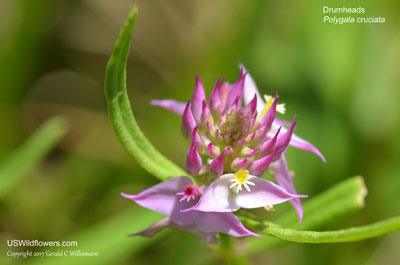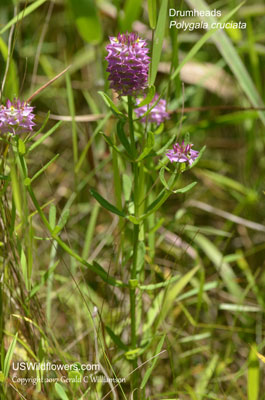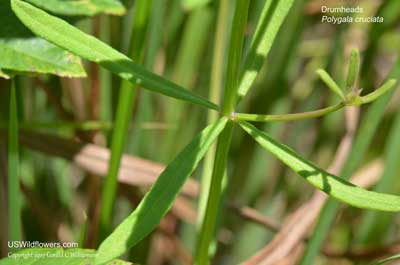Drumheads, Crossleaf Milkwort, Candy Root - Polygala cruciata
|
Polygala cruciata - Drumheads, Crossleaf Milkwort, Candy Root. Polygala - Milkwort - is a very large genus with somewhere between 300 and 500 species worldwide. Recent reclassification probably leaves it closer to the lower end of that number than the high end, but still 300 to 400 species makes for a large genus. 40 - 60 species are found in North America. While more of those are in the eastern half of the continent than in the west, there is at least one species found in all but 2 to 4 states - missing from Alaska and Idaho; it's presence in Washington and Nevada is apparently disputed.
Polygala cruciata - Drumheads - is a species which requires moist soil and is therefore more prevalent in the coastal plains of the eastern half of the United States and Canada, but it is found in bogs and wet savannahs well into the interior. It is found in every state east of the Mississippi except for Vermont, and in a scattering of states west of that great river as well - to eastern Texas and Oklahoma. While it is fairly common in much of its range, it is protected in at least 9 states.
Found in:
AL, AR, CT, DC, DE, FL, GA, IA, IL, IN, KY, LA, MA, MD, ME, MI, MN, MS, NC, NH, NJ, NY, OH, OK, PA, RI, SC, TN, TX, VA, WI, WV
Leave comments on Polygala cruciata at this link. | 
Distribution of Polygala cruciata in the United States and Canada:

Blue=Native; Grey=Introduced
Map from USDA Plants Database:
USDA, NRCS. 2017. The PLANTS Database (http://plants.usda.gov, 08 May 2025). National Plant Data Team, Greensboro, NC 27401-4901 USA.
Search Our Database: Enter any portion of the Scientific, Common Name, or both.
Do a general Google search of the entire site:
#ad
 Follow USWildflowers on Twitter
| | Site: AEDC, Coffee County, TN Date: 2017-July-10 | Photographer: Gerald C. Williamson
Nikon D7000
Tamron SP 90MM f/2.8 AF Macro | | The inflorescence of Drumheads is a dense raceme, with about 50 flowers per inch of peduncle (vs. 25 in similar P. hookeri.) The flowers are usually pink and white (with yellow tips), but may be entirely white. The raceme may be up to about 2.5 inches long. The elongated points of the wings may cross each other, creating a bit of a thatched look. | | 
| | Site: AEDC, Coffee County, TN Date: 2017-July-10 | Photographer: Gerald C Williamson
Nikon D7000 | | The flowers of Milkwort (Polygala) species have 5 sepals and 3 petals. In Polygala cruciata the two pink wings are 2 large petal-like sepals. The other three sepals are small and underly the rest of the flower. The 3 petals are may be pink, or may be white tipped with yellow (at least during part of their lifecycle), and are joined at the base, forming a tube with a keel-shaped lower petal around the stamens and style. The keel may have a fringed tip. The wings are 3-4mm wide and terminating in an elongated point. (The tips of the wings of similar P. brevifolia are also pointed but not as elongated.) The raceme may be very short. | | Click on the photo for a larger image

| | Site: AEDC, Coffee County, TN Date: 2017-July-10 | Photographer: Gerald C Williamson
Nikon D7000 | | Polygala cruciata grows up to about 12 inches tall with occasional branches. | | Click on the photo for a larger image

| | Site: AEDC, Coffee County, TN Date: 2017-July-10 | Photographer: Gerald C Williamson
Nikon D7000 | | The leaves of Polygala cruciata are entire, linear or narrowly oblanceolate, and up to 1.5 inches long. They are normally in whorls of four leaves, with the cross-appearance providing the species epithet - cruciata. Branches may form in the axils of the leaves. | | Click on the photo for a larger image

|
References used for identification and information:
|
|
| |
| #ad
|
|






